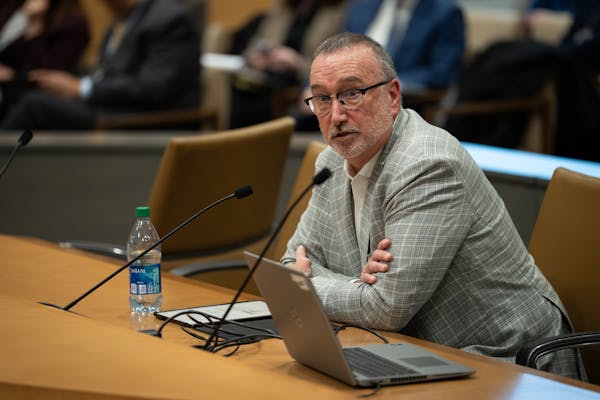Minnesota's largest nonprofit groups once again are all about health care, the Star Tribune found in its annual review.
Eight are primarily health systems that run hospitals and clinics. Three are health insurers. And one is a hybrid, straddling both sides.
And while hospital operators have faced significant challenges recently, it's the health insurers that enjoyed a three-year period of annual profits up through the most recent 2022 data, according to an analysis on financial performance and executive compensation at Minnesota's big nonprofits.
The large nonprofit insurers — Blue Cross and Blue Shield of Minnesota, HealthPartners, Medica and UCare — had to pay fewer medical claims during the early COVID era. In addition to lower payments, their balance sheets were then bolstered, to varying degrees, by record-setting income from the state's Medicaid program.
Yet these same businesses are now bracing for rising health care costs and tough questions at the state Capitol that could affect their income.
Minnesota DFL lawmakers passed a bill last year that could eventually prevent the largest nonprofit and for-profit health plans from managing patient care in Medicaid and related programs for lower-income residents. By January 2026, the state Department of Human Services must develop an implementation plan for a new approach that might include dropping the big managed care organizations.
Insurers profiting from state Medicaid programs, the biggest of which being pre-paid Medical Assistance, is part of the concern for critics.
"We have this situation where some of them are making big bucks and the Medical Assistance system is really under stress — and the providers are really under stress. So, how do you put those things together?" asked Rep. Tina Liebling, DFL-Rochester. "My issue is: Why are we paying them so much and getting so little?"
Health plans say they welcome the state's review, believing it will show they're providing good value to the state by coordinating care for beneficiaries.
"We think that the track record proves that the nonprofit health plans ... have responsible margins around these public programs — and have supported Minnesotans with access to care," said Lucas Nesse, chief executive of the Minnesota Council of Health Plans, a trade group.
Four nonprofit health insurers show up in the top half of the Star Tribune's annual list of Minnesota's 12 largest organizations, this time based on revenue in 2022.
Bloomington-based HealthPartners, which provides both care and coverage, ranked second, with about $8.2 billion in revenue. Eagan-based Blue Cross came in at No. 3, while health insurers Medica and UCare landed, respectively, in the fifth and sixth spots.
Outside of the health insurers, the remainder of the list is composed of health systems. Once again, Rochester-based Mayo Clinic was the state's largest nonprofit with more than $16 billion in revenue from hospitals and clinics in Minnesota and four other states.
Minnesota was one of the first states to hire health insurers to manage care for beneficiaries in Medicaid, which is jointly funded by states and the federal government. The push started in the 1980s when there was growing concern over the program's escalating costs, said Andy Schneider, a research professor at the Georgetown University McCourt School of Public Policy.
Before private insurers such as HMOs got involved, Medicaid programs generally paid on a "fee-for-service" basis, where hospitals and doctors received a payment every time they billed for a service. Under this system, the more services a provider furnished, the more the provider was paid, giving them an incentive to increase costs, Schneider said during a University of Minnesota forum in January called "Managing Medicaid and the Debate at the Capitol."
With managed care, states paid health plans a fixed amount per-person, per-month and thereby hoped to flip the incentives toward giving financial rewards for keeping people healthy, Schneider said. This also provided lawmakers with more predictability on Medicaid expenses, which are some of the greatest costs in most state budgets.
'We don't know which plans are doing the best'
Forty states plus the District of Columbia provide Medicaid coverage through managed care companies, Schneider said, but there's been a lack of transparency about how well this has worked for beneficiaries.
Researchers at the Georgetown Center for Children and Families scanned the websites of 17 state Medicaid agencies, he said, looking for data that would allow them to judge the performance of individual managed care plans on child and maternal health. They were not able to find it.
Minnesota was not included in the study. Schneider said this information void also prevents researchers from comparing the relative quality of for-profit and nonprofit health insurers in the program. Minnesota reserved the market solely for nonprofit HMOs until a 2017 law allowed for competition from for-profits, including Minnetonka-based UnitedHealthcare.
"We don't know which plans are doing the best in each state," Schneider said. "The state administrators know. The plans know. And possibly the federal agency that oversees Medicaid — the Centers for Medicare and Medicaid Services — knows. But we don't, and we tried to find out."
Medicaid premium revenue grew significantly without a corresponding increase in underlying use of medical services, said Allan Baumgarten, an independent health care analyst in St. Louis Park. This resulted in an "extremely profitable" year for the health plans, he said.
In 2022, the four nonprofit insurers on the Star Tribune list saw collective operating earnings from Medicaid of about $625 million for an overall profit margin of about 6.4%. Margins more typically range from 1% to 3%, said Nesse of the Minnesota Council of Health Plans. The trade group argues that "profit" is a misnomer; excess revenue for nonprofit health insurers is reinvested in operations rather than paid to shareholders.
After losing money on operations in 2019, UCare saw profits grow as states and the federal government allowed for continuous Medicaid enrollment during the COVID public health emergency. Also, a cap on profits in Minnesota during 2020 and 2021 was removed during 2022 in anticipation of eligibility checks resuming in Medicaid, the health insurer said. These redeterminations typically lower enrollment totals, but they didn't start until 2023. UCare says finances are now returning to pre-pandemic levels.
Medicaid was also a key driver of 2022 profits at Blue Cross, although the insurer said it lost money on the state business over a four-year span prior to the pandemic.
HealthPartners said medical costs are trending up, including significantly higher pharmacy expenses.
While nonprofit health insurers saw profits, several health systems saw annual losses between 2020 and 2022. Fairview lost money all three of those years while Allina Health and Hennepin Healthcare posted losses during two of them.
Mayo Clinic, however, was consistently the most profitable.
The Minnesota Hospital Association has been raising alarm over the financial results, highlighting labor shortages and supply costs. But Baumgarten noted that stock market gains over the past year have provided a financial cushion for health systems via their investments.
"They have significant amounts of money on their balance sheets," he said. Pointing to construction projects at Allina and HealthPartners, Baumgarten said: "They're continuing to make investments."

Bushel Boy, Minnesota's local tomato grower, sold
After 60 years, federal cuts shutting down Job Corps center in St. Paul

In a first, Minnesota doctors walk their own picket line, then hustle to see patients
It's harder to find a job this year, especially a corporate position

